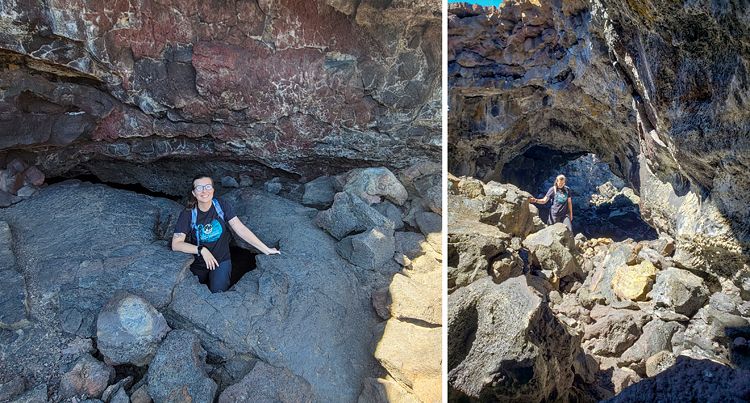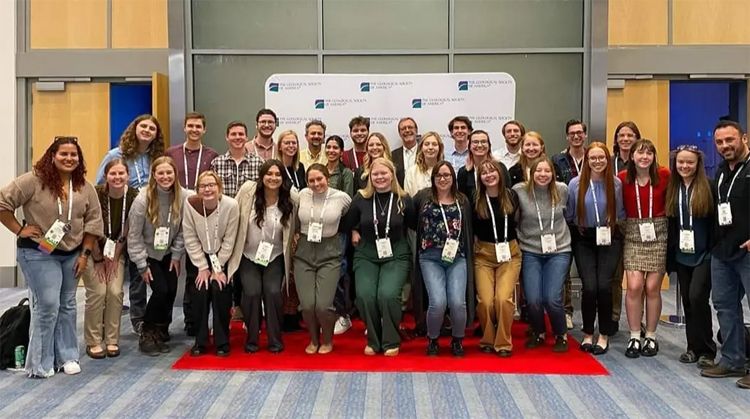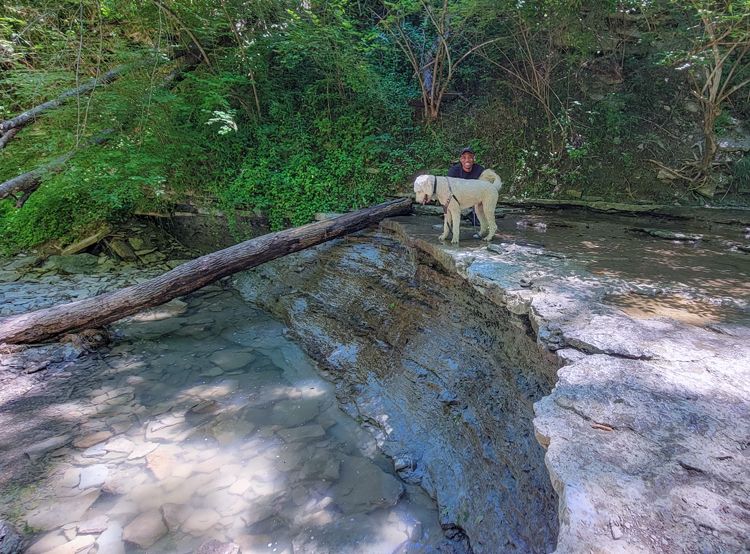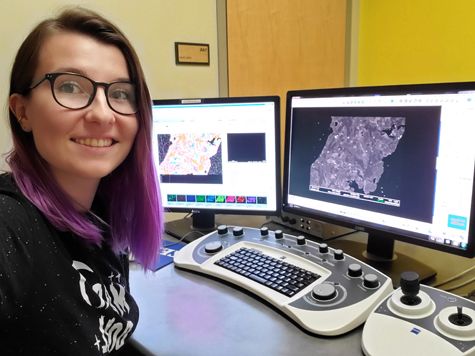Early Career Scientist Spotlight
Dr. Aleks Gawronska (she/her)
Lunar Petrologist
Planetary Geology, Geophysics and Geochemistry Laboratory (698)
What motivated you to pursue a career in lunar geology?
When I was young, I would spend a lot of time outside with my grandma – we’d walk through the forest picking mushrooms, go to the nearby beach, garden in her yard, watch bees pollinate flowers, etc. This made me really interested in the natural world around me, and I decided I wanted to be a scientist at a young age even though I didn’t fully know what “science” was. Years later when I began my undergraduate studies, an academic advisor suggested that I should join a research group so that I could begin learning how research is performed. I joined one lab studying fish diets, one studying uranium ores, and one studying rock samples from the Moon. All three labs perform important and exciting research, but when I viewed a thin section of a sample from the Moon under a light microscope, I was blown away that this one rock could help us understand how an entire planetary object evolved. The rock I was looking at was a basalt – it formed after magma was generated in the lunar mantle, traveled through the lunar crust, erupted as lava and cooled on the lunar surface, and was picked up by astronauts billions of years later and brought to Earth. In a nutshell, this describes the field of igneous petrology, where igneous rocks are studied to determine how they formed. I continue to be excited by the information that can be gathered by studying igneous rocks like basalt in great detail, and I love how that process can be used to learn about rocky bodies in our Solar System.
What science questions do you investigate?
Broadly speaking, I am keenly interested in how magmas evolve at depth prior to eruption, and what implications their eruptions have across planetary surfaces. While many types of rocks are produced in this way, I am mostly interested in basalt due to its ubiquity across rocky planets – basaltic rocks exist on Earth, the Moon, Mars, Venus, certain asteroids, and Jupiter’s moon Io! Basalt is produced when magmas of low SiO2 and high Mg and Fe content (relative to a high SiO2, low Mg and Fe rock like granite) erupt on a planetary surface, which causes them to cool very quickly and crystallize mineral grains of specific physical and chemical characteristics. In the past decade, studies of basaltic systems on Earth have revealed that some basaltic samples preserve mineral grains of unexpected physical and chemical characteristics, indicating that magmatic systems can be “open” and allow exchange of mineral populations between two (or more) distinct magma batches. However, questions remain regarding the extent to which such processes operate on other planetary objects, and the implications this may have for our understanding of magmatism and volcanism across the Solar System. Through my work I aim to answer these questions by evaluating the physical and chemical attributes of basaltic rocks from the Moon and evaluating their petrogenetic histories.
In some cases, magmas contain dissolved gas that can be released during or after an eruption. Recent evidence suggests that volatile species like water were present in lunar magmas and degassed during their emplacement on the surface; additional research suggests that water is now concentrated at the poles of the Moon. It is not yet clear where lunar polar water originated and how it came to be relatively concentrated at the poles, but it will be an important resource for any long-term, sustainable human presence on the Moon. This has made me recently interested in whether water and other species may have been delivered to the surface of the Moon endogenously as a result of basaltic eruptions, and, considering that the majority of eruptions on the Moon took place ~3.5 billion years ago, what evidence of degassed volatile species remains on the lunar surface in general. To address this, I have previously investigated the geology of the lunar south pole using remote sensing datasets, and am currently participating in missions examining lunar volatiles in-situ.

Credit: Kailee Gokey
What was your first big research achievement?
As a senior undergraduate student, I had the opportunity to lead my own research project to investigate how some Apollo 14 samples with unexpectedly high whole rock potassium content formed. With help from my research mentor, I presented this project at the annual Lunar and Planetary Science Conference. This was my first presentation at a major scientific conference, and I was so stressed out that I blacked out and to this day don’t remember much of what I said. Nonetheless, I ended up winning an Honorable Mention award for best undergraduate oral presentation. While I technically got 2nd place, this confirmed to me that I didn’t just like science, I was also good at performing research and speaking about it, which was a great compliment to receive before starting graduate school.
What early career advice do you have for those looking to do what you do?
The most important advice I have is to do your best to find good mentors, and people that are willing to support your growth and your success. I can say with 100% confidence that I would not be where I am today without the support of good mentors who cared about my success and development as a scientist, specifically within the planetary geology field. I have had mentors who have lied to me and ghosted me when I needed help, and I have friends whose mentors would actively stand in the way of research progress. I cannot stress the importance of finding people who are excited to work with you.
What is one space mission that you are particularly excited about, and why?
As a sample scientist I am always excited by sample return missions, and I cannot wait for Artemis 3 and all subsequent Artemis missions to return new samples from the Moon! Some may think that we’ve “been there, done that” regarding the Moon, but to date we have only sampled in 10 discrete locations (6 by Apollo, 3 by Luna, 1 by Chang’e) which may not be fully representative of the lithologies that are actually present on the Moon. The collection of new, unique samples may confirm or challenge our current understanding of how the Moon formed and evolved over time which also affects our understanding of the Earth-Moon system. So, it is definitely important to continue exploring. If you could only visit 10 locations in the United States, how much would you know about the North America continent? (Not quite to scale – the Moon is ~1.5 North America continents)
Who inspires you?
This may be a cheesy answer, but I am most inspired by the scientific community around me as a whole, and the amazing work they do to investigate the world around us. I love hearing about new discoveries made by friends and colleagues I know personally, and I am always excited to see new information presented at conferences. I think all of us work incredibly hard to generate the results we do, and I really enjoy being part of the scientific community.

Credit: unknown fellow conference attendee
What do you like to do in your free time?
I try to go outside and enjoy time in the sun as much as possible, while learning more about regional geology. NASA Goddard is about an hour away from the Appalachian foothills, and since moving to this area I have decided to seriously take up hiking and take advantage of national parks and state parks in the area, and I even hope to hike portions of the Appalachian Trail eventually with my partner and our dog. In addition to this, I enjoy rock climbing and have recently started learning how to prepare some traditional Polish dishes I grew up with like pierogi.

Credit: Aleksandra Gawronska
Biography
Home Town:
Gdańsk, Poland, and Winthrop Harbor, IL
Undergraduate Degree:
BS in Environmental Science with a concentration in Earth Science, University of Notre Dame, South Bend IN
Post-graduate Degrees:
PhD in Geology, Miami University, Oxford OH

Link to Dr. Gawronska's GSFC Bio
